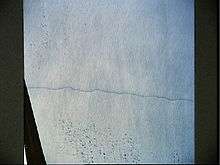Front (oceanography)
In oceanography, a front is a boundary between two distinct water masses.[1] The water masses are defined by moving in different directions, i.e. on one side of the front the water is generally moving in one way, and on the other side of the front, the water is moving in another. Depending on the directions of the water masses, a front may be defined as convergent or divergent. The water masses on either side of a front may also have different temperatures, salinities, or densities, along with differences in other oceanographic markers.[1] While most fronts form and dissipate relatively quickly, some, such as the fronts caused by the antarctic circumpolar current, persist for long periods of time.
Types of Fronts
There are two general front types, convergent fronts and divergent fronts.
Convergent Fronts
Convergent fronts occur when the water masses on both sides of the front are moving towards the front and hence each other. At convergent fronts, the water is often warmer than in the surrounding area, and a buildup of water at the front leads to a slightly higher sea level. This buildup causes increased pressure on the water column, and leads to downwelling at the front.[1] A convergent front may accumulate buoyant material such as marine debris and sargassum which moves to the front with the water masses, but then resists the downward flow of the water. Convergent fronts sometimes support local marine communities by aggregating buoyant organisms in this manner.[2]

Divergent Fronts
Divergent fronts occur when the water masses on both sides of the front are moving away from the front and hence each other. At divergent fronts, the water is often cooler than in the surrounding area, and water moving away from the front leads to a slightly lower sea level. This causes decreased pressure on the water column, and leads to upwelling at the front.[1] This upwelling can bring nutrients to the surface and lead to phytoplankton growth. This phytoplankton growth can in turn support other marine organisms in the area.
Causes
Fronts have a variety of causes, which involve ocean currents, wind, and coriolis forces.
Notable Fronts
Some specific names for fronts exist, including subtropical fronts, which separate warmer temperate water masses from colder polar water masses, and Langmuir fronts, which are the result of Langmuir circulation.